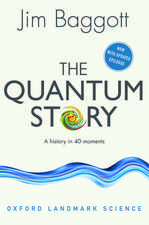Nuclear and Particle Physics: The Changing Interface: Springer Series in Nuclear and Particle Physics
Autor Mira Dey, Jishnu Deyen Limba Engleză Paperback – 25 dec 2011
Preț: 378.54 lei
Nou
Puncte Express: 568
Preț estimativ în valută:
72.43€ • 75.83$ • 59.93£
72.43€ • 75.83$ • 59.93£
Carte tipărită la comandă
Livrare economică 07-21 aprilie
Preluare comenzi: 021 569.72.76
Specificații
ISBN-13: 9783642849671
ISBN-10: 3642849679
Pagini: 128
Ilustrații: IX, 109 p.
Dimensiuni: 155 x 235 x 7 mm
Greutate: 0.19 kg
Ediția:Softcover reprint of the original 1st ed. 1994
Editura: Springer Berlin, Heidelberg
Colecția Springer
Seria Springer Series in Nuclear and Particle Physics
Locul publicării:Berlin, Heidelberg, Germany
ISBN-10: 3642849679
Pagini: 128
Ilustrații: IX, 109 p.
Dimensiuni: 155 x 235 x 7 mm
Greutate: 0.19 kg
Ediția:Softcover reprint of the original 1st ed. 1994
Editura: Springer Berlin, Heidelberg
Colecția Springer
Seria Springer Series in Nuclear and Particle Physics
Locul publicării:Berlin, Heidelberg, Germany
Public țintă
ResearchCuprins
1 Introduction.- 1.1 Quarks.- 1.2 Colour.- 1.3 Flavour.- 1.4 Quark Masses.- 1.5 Medium Effects on Quarks and Their Interactions.- 1.6 Phase Transition and Quark Gluon Plasma.- 2 Preliminaries and Simple Models.- 2.1 SU(2) and SU(3) Symmetry.- 2.2 The SU(3) Group.- 2.3 Non-Abelian Gauge Transformations.- 2.4 SU(3) Flavour Group.- 2.5 The SU(3) Colour and the Multi-Quark Wave Function.- 2.6 The Necessity of Relativistic Models.- 2.7 Fully Relativistic One-Body Potential Models.- 2.8 Relativistic Hartree-Fock Models.- 3 Currents, Anomaly, Solitons and Fractional Fermions.- 3.1 The Theorem of Emmy Noether.- 3.2 Internal Symmetry and Space-Time Symmetry.- 3.3 Standard Examples.- 3.4 Current Algebra and Anomaly.- 3.5 Fractional Fermions.- 3.6 A Brief Review of Solitons: Kinks.- 3.7 Polyacetylene: One Dimensional Dirac-Type Equation.- 4 More on Chiral Anomaly.- 4.1 Chiral Anomaly in QED.- 4.2 Gentleness.- 4.3 Momentum Routing Anomalies.- 4.4 Anomalous Ward Identity from Path Integral Approach.- 4.5 Summary of Grassmann Algebra.- 4.6 Integration Over Fermi Fields.- 4.7 Chiral Transformation.- 5 Introduction to Instantons.- 5.1 Instantons or Pseudoparticles.- 5.2 Tunneling in Imaginary Time.- 5.3 Homotopy Theory.- 5.4 Compactification of Space-Time Manifold and Mapping.- 5.5 Bounds for the Instanton Solutions.- 6 Relevance of Instantons.- 6.1 ? Vacuum.- 6.2 The DEMON.- 6.3 Electroweak Baryon Number Violation.- 6.4 Conformally Invariant Solutions of Jackiw, Nohl and Rebbi.- 6.5 Instanton to Skyrmion.- 6.6 QCD Vacuum — Instanton Gas or Liquid?.- 6.7 Instanton Suppression by Light Fermions.- 6.8 Instanton Induced Effective Interaction.- 7 Chiral Perturbation Theory (CHPT).- 7.1 CHPT for the Meson Sector.- 7.2 CHPT for the Nucleon.- 7.3 CHPT at Finite Temperature.- 8 TheTopological and Non-Topological Soliton Models.- 8.1 Skyrmion: Baryon as a Topological Soliton in Meson Fields.- 8.2 The Non-topological Soliton or the Soliton Bag Model.- 8.3 The Nature of the QCD Vacuum.- 8.4 Description of the Model.- 9 QCD Sum Rules.- 9.1 Introduction to QCD Sum Rules.- 9.2 The Operator Product Expansion (OPE).- 9.3 Calculation of the Coefficients and Borel Transform.- 9.4 Introduction to Sum Rules for Baryons.- 9.5 The Nucleon Correlator.- 9.6 Details of the Sum Rule for Nucleons.- 9.7 Finite Temperature and Density.- References.- Citation Index.























